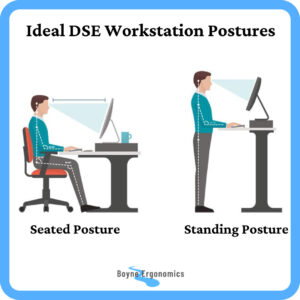During DSE workstation assessments, we put a huge emphasis on trying to achieve the optimum DSE workstation posture, but does it really matter? To put it bluntly, yes it does matter, in the short and the long term.
Adverse postures, along with prolonged sitting, longer working hours and increased stress levels, can increase the risk of developing health issues that can have a negative impact for years to come.
In this blog post, I will outline why posture is important, common adverse postures associated with computer workstations, the negative effects of adverse postures, what constitutes a good / neutral computer workstation and tips to maintain a neutral posture during the working day.
What is Posture and Why Is It Important?
When we talk about posture, what we are referring to is the body’s alignment and positioning in relation to gravity. In any posture, gravity exerts forces on the musculoskeletal system.
When we adopt ‘good’ or neutral postures, the force of gravity is distributed appropriately, with no excessive stress placed on any one joint or muscle group. In these postures, the body is more efficient, we experience reduced fatigue and strain, and our respiratory, circulatory and digestive systems are optimized.
When we adopt ‘bad’ or adverse postures, there is excessive strain placed on particular tissues and joints and some muscle groups have to work harder to maintain that positioning. The body becomes inefficient and our respiratory, circulatory and digestive system can experience reduced functionality.

What Are The Impacts of Adverse Workstation Postures?
The increase in home working due to COVID-19 saw a corresponding increase in poor, or adverse, postures when working at the computer. This is due in part to poor home workstation setup, lack of appropriate equipment and a lack of training and knowledge regarding the DSE related risks.
While no one posture will have a negative impact if it is maintained for a short period of time and infrequently, the issue with these types of adverse postures is that they are often maintained for prolonged periods and on a regular basis. Prolonged duration and high frequency of exposure increases the risk of discomfort and injury.
Adverse postures have a negative short and long-term impact on the musculoskeletal, digestive, respiratory and circulatory systems as well as your psychological well being.

Impact on Musculoskeletal System
Leaning forward and looking down at the monitor causes the weight of the head to be supported by increased musculoskeletal effort and stretched ligaments, instead of being balanced over the spine.
Rounding of the upper and lower back also causes abnormal compression of the spinal discs, leading to increased abnormal wear and tear, as well as misalignment of the spine.
This causes increased neck, shoulder, upper back, lower back and hip pain.
Impact on Digestive System
Rounded shoulders and back compresses the organs of the digestive system. This reduces digestive function, increasing the risk of acid reflux and constipation. Noticing an increase in heartburn since working from home? Check your posture (and diet)!
Impact on Respiratory System
Rounded shoulders and back causes the muscles in the chest to tighten, limiting rib cage expansion and preventing the diaphragm from opening fully. This results in a more rapid and shallow breathing pattern. This encourages activation of the nervous system and causes the body to be in a state of stress.
Adverse posture also causes additional strain on the primary breathing muscles. The body responds by recruiting other muscles to help with breathing. These are usually the neck muscles, which then become overworked resulting in neck pain, shoulder pain, headaches and migraines.
Impact on Circulatory System
Adverse postures reduce blood flow to the muscles and internal organs affecting their ability to function efficiently.
Increased pressure on the veins, especially in the legs, can damage them and cause varicose veins.
Impact on Sleep
Adverse postures cause increased tension in the muscles, making it difficult to relax the body at night. Muscular pain and discomfort can make it difficult to get into a comfortable position to fall asleep and can increase night wakening. This reduces the duration and quality of sleep.
Impact on Mood
The negative effects mentioned above can act to negatively affect our mood and psychological well being. Adverse postures also negatively affect the nervous system, including compression of the nerves, causing a chain reaction that negatively impacts your emotional and psychological wellbeing.
Just as adverse postures can negatively impact the body, neutral and supported postures can maintain efficient body function.
What Is The Ideal DSE Workstation Posture?
- Stable base – Feet planted on the floor or on a footrest / books / box
- Hips slightly above knees – this will open the hips and allow normal curvature of the spine.
- Ensure your lower back is supported – this will help reduce the static load. If your chair has no lumbar support, add a cushion, pillow or rolled up towel at your lower back.
- Sit upright with your chest open – this will improve oxygen intake.
- Ensure your elbows are level with your desk surface – this will encourage an upright posture and reduce strain on the shoulders, arms and wrists. if your seating is not height adjustable, add cushioning to the seat to elevate your seated position.
- Ensure the top of your monitor is in your eyeline – this will encourage an upright posture and reduce neck strain. If you are using a laptop, raise it on a laptop stand, books or boxes and use an external keyboard and mouse.
- Keep inputting devices close to your seated position – this will reduce the strain on your shoulders, arms and wrists.
- If using the workstation in a standing position, ensure that your elbows are level with the top of the work surface when typing

How Can You Encourage Ideal DSE Workstation Postures During The Day?
- Ensure your workstation is set up as best it can to encourage neutral postures.
- Take regular microbreaks every 30 – 45 minutes from the computer. Even with an ergonomically sound workstation, muscular fatigue will still be a factor and will encourage adverse postures. Regular microbreaks will reduce muscular fatigue when seated. Break reminder apps on your phone can be a great external reminder to encourage these frequent breaks when working from home.
- Alternate postures regularly. When working from home, use video calls as an opportunity to move to a standing position by placing the laptop on a high surface and taking the video call in a standing position, taking the video call on your mobile or investing in a set of wireless headphones, turning off the camera at intervals to walk around.
- Regular aerobic exercise and / or Pilates will improve muscle tone and encourage improved posture.


